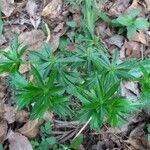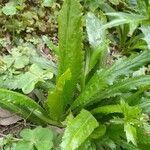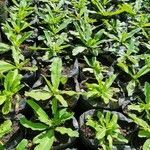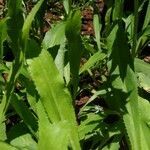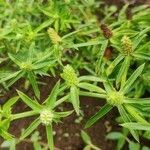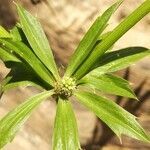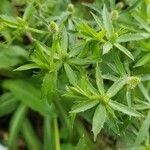Plants 8–40 cm high from a basal rosette. Taproot fusiform with fibrous roots. Stem green. Basal leaves numerous; petiole short or obsolete, sheath up to 3 cm; blade lanceolate or oblanceolate, entire, 5–25 × 1.2–4 cm, venation pinnately reticulate, base cuneate to decurrent, apex obtuse, callous-margined, crenate to finely spinulose-serrate. Upper leaves sessile, opposite deeply spinulose-serrate to parted. Inflorescence divaricately trifurcate; lateral branches often continuing to form a monochasium, heads numerous, short-pedunculate. Flower heads cylindrical, 5–12 × 3–5 mm; bracts 4–7, foliaceous, lanceolate, 1.5–3.5 × 0.4–1 cm, spreading to reflexed, margin 1–3-spinulose-serrate; bracteoles lanceolate, 1.5–1.8 × ca. 0.6 mm, brightly scarious-margined. Calyx teeth ovate-lanceolate, 0.5–1 mm, acute, equaling petals. Petals white or pale yellow. Styles erect, ca. 1.1 mm, exceeding calyx teeth. Fruit ovoid-globose, 1.1–1.3 mm, covered with tubercles. Fl. and fr. Apr–Dec.
Roots fusiform. Stems 15-60 cm, many times di-monochasially branched with spreading branches, subglabrous, grooved. Leaves nearly all in a rosette, 3-32 by 1-4 cm, glabrous, lanceolate-spathulate, obtuse, sessile, base more or less narrowly sheathy, margin dentate, teeth with a spiny hair. Bracts of the inflorescences 1-6 cm, palmatilobate to-partite, with spiny tips and teeth, strongly nerved, lowermost often like normal leaves. Peduncles 1-10 mm; heads 5-10 mm, cylindrical; involucres 5-7, spreading, nearly lanceolate with few spiny teeth. Flowers sessile in the axils of narrow membranous-margined bracts 1¼-1½ mm long. Calyx teeth nearly ¾ mm, lanceolate, acute with narrow membranous margin. Petals ½-¾ by ±¼ mm, greenish white. Mericarps 1-1½ by ½-¾ mm, densely warty, glabrous, ribs indistinct.
Slender herb, the stem usually solitary, erect, branched, 0.5-6 dm. tall; basal leaves lanceolate or oblanceolate, the blade 3-27 cm. long, 1-5 cm. broad, cuneate, obtuse, the petiole short or obsolete, up to 3 cm. long; cauline leaves numerous, the upper sessile and usually opposite, spinulose-serrate to parted; inflorescence tri-furcate, the lateral branches usually continuing to form a monochasium, the heads numerous, 7-11 mm. long, 3-5 mm. broad; bracts 5 or 6, 1-4 cm. long, 2-10 mm. broad, entire or nearly so, green on both surfaces, greatly exceeding the head, the bractlets linear to lanceolate, 2-3 mm. long, exceeding the fruit, the coma conspicuous or lacking; calyx-teeth lanceolate to ovate, acute, weakly mucronate; styles slightly exceeding the calyx; fruit globose, about 1.5 mm. long.
A herb. It grows 15-50 cm high. It has one stem. The leaves are all near the base of the plant. The leaves are 7-15 cm long by 1-2 cm wide. The leaves have teeth along the edge. The flower head is oval. It is 5-8 mm long by 3-4 mm wide. The flowers are greenish-white. The fruit is almost round and 2 mm across.
A fleshy rootstock exuding latex
A spiny leaved perennial herb
An unpleasant smell
Flowers green.
